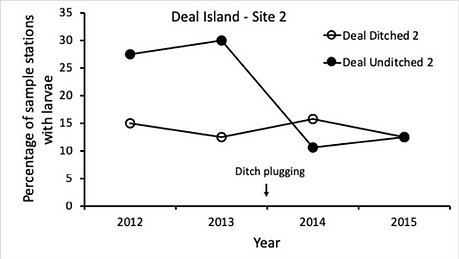The Deal Island Marsh & Community Project
How Marsh Restoration Affects Mosquito Populations
Paul Leisnham, University of Maryland Environmental Science
and Technology Department
Since the early 1900s, parallel grid ditching has been practiced on Atlantic coastal salt marshes to control mosquitoes. But there is little evidence that ditching reduces the abundance of pestiferous and disease-vector mosquitoes. Instead there is data indicating that it can alter marsh hydrology and the overall health of the marsh ecosystem. Some impacts of ditch plugging include lowering water table levels, changing the natural vegetation community of the marsh, and degrading the habitat of wildlife.

Aerial of the ditch system in the Deal Island Wildlife Management Area. These ditches were constructed to help control mosquito populations. Photo Credit: Jane Thomas, Integration and Application Network, University of Maryland Center for Environmental Science (ian.umces.edu/imagelibrary/).

A researcher walking through the EA Vaughn site with a standard mosquito “dipper” that is used to sample larval mosquitoes.

Markers indicating random stations along transects where mosquito samples were taken.
In order to address this concern, mosquitoes were sampled in three pairs of ditched and unditched marshes (two pairs on Deal Island and one pair at EA Vaughan, coastal bay site ~30 miles beeline away) during each summer from 2012 to 2015. Mosquito larvae were sampled at random stations along transects using standardized dippers 4-5 days after high tide events, when mosquito egg hatching is expected. In April 2014, MD-DNR plugged ditches at the three ditch-drained marsh sites to create a before-after-control-intervention (BACI) experimental design with two summer seasons before (2012, 2013) and after (2014, 2015) marsh restoration at the three formally ditch-drained marsh sites.
The results of this work show that at two sites (Deal Island – Site 3 and EA Vaughn – site 2), there were higher percentages of sample stations with mosquitoes in the unditched versus ditched marsh, but that these differences
Further, ditching may also reduce the ability of the marsh to increase or maintain its elevation at the same pace as sea level rise. In response to these concerns, the Maryland Department of Natural Resources (MD-DNR) has considered restoring marshes by plugging ditches to promote their natural hydrology and ecological functioning and their resilience to sea-level rise. However, an important concern from various stakeholders is whether or not such restoration increases mosquito production.
disappeared after ditch-plugging (Fig 1). The majority of collected mosquitoes were Anopheles bradleyi, but this species declined from 95.1% to 80.2% of total larvae after ditch-plugging. The third site, Deal Island Site 1, had very little mosquito activity in any project year. These results suggest that ditch-plugging may eliminate the ability of ditched marsh to reduce mosquito production and alter community composition. With that said, however, overall mosquito densities at these marsh sites were over five times lower than habitats in neighboring forest sites and those recorded from marsh in other studies in New Jersey and New England. These findings suggest that while ditch-plugging may increase mosquitoes on the marsh surface at these sites - and possibly many marsh sites in Maryland - their overall mosquito production is comparatively low and much greater mosquito production is likely to occur in upland forested sites. Ongoing data analyses are attempting to relate changes in mosquito ecology with changes in water levels and fish populations to help explain the mechanisms that ditch-plugging may affect mosquito production.
For general information on the mosquitoes that inhabit Maryland’s costal saltmarsh and related control programs, visit the Mosquito Control section of the Maryland Department of Agriculture (https://mda.maryland.gov/plants-pests/pages/mosquito_control.aspx).
Figure 1: Results of Ditch-Plugging Intervention on Mosquito Populations

Ditch plugging

